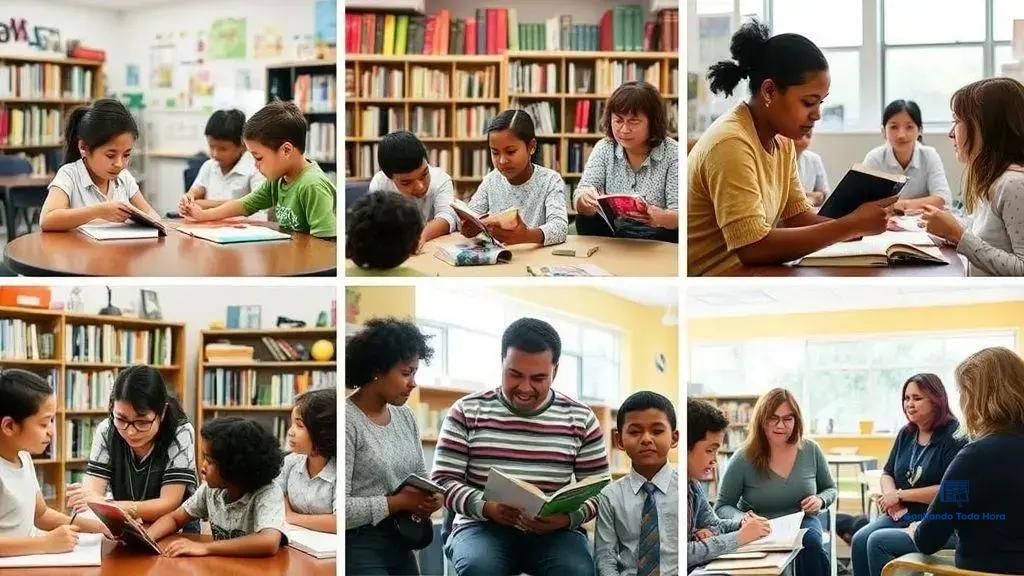Literacy improvement grants: unlock funding for education

Anúncios
Literacy improvement grants provide essential funding to enhance reading skills among students, supporting programs that lead to measurable improvements in literacy rates and engagement within communities.
Literacy improvement grants provide essential resources for educators aiming to enhance reading skills among students. Have you ever considered how such funding can transform your teaching approach? Join us as we explore the benefits and application process for these vital grants.
Anúncios
Understanding literacy improvement grants
Understanding literacy improvement grants is crucial for educators seeking to enhance their teaching methods and student outcomes. These grants provide valuable resources that can make a significant difference in classrooms.
What Are Literacy Improvement Grants?
Literacy improvement grants are funds allocated to support initiatives aimed at enhancing literacy skills among students. These grants can be awarded to schools, non-profit organizations, and community programs dedicated to literacy development.
Types of Literacy Improvement Grants
There are various types of grants available to support literacy initiatives. Understanding these can help educators choose the best fit for their needs.
- Federal grants that provide substantial funding for large-scale projects.
- State grants aimed at specific educational requirements within local education agencies.
- Private grants from foundations that focus on innovative literacy programs.
Each type serves a unique purpose, allowing educators to select grants that align with their specific goals.
Anúncios
Applying for these grants can seem daunting, but it’s essential to understand the process. Usually, you will need to outline how the funds will be used to enhance literacy and provide measurable outcomes. This a vital step as it assures funders that the money will lead to meaningful improvements.
Importance of Literacy Improvement Grants
Utilizing literacy improvement grants offers educational institutions the tools they need to address literacy challenges effectively. With these funds, schools can develop tailored programs that meet the unique needs of their student populations.
Moreover, these grants foster collaboration among educators, communities, and literacy organizations, creating a comprehensive approach to enhancing literacy skills. When educators share resources, they maximize the impact of their efforts.
In summary, literacy improvement grants are pivotal in driving literacy growth in schools. By understanding what these grants are and how to apply, educators can leverage these opportunities to make a real difference.
Types of literacy grants available

There are many types of literacy grants available for educators and organizations striving to improve reading skills. Understanding these different types can help you select the right funding for your literacy initiative.
Federal Literacy Grants
Federal grants are a primary source of funding, aimed at larger projects that can have a significant impact. They come from government bodies like the U.S. Department of Education.
- Target underperforming schools in low-income areas.
- Support innovative solutions for literacy challenges.
- Provide substantial funding to develop comprehensive programs.
These grants usually require a detailed application outlining how the funding will be used and the expected outcomes.
State Literacy Grants
State grants are offered by state education agencies. These grants typically focus on specific educational needs within each state.
- Available for local education agencies to implement literacy programs.
- Assist schools in meeting state literacy standards.
- May support professional development for educators.
Applying for state grants can often be simpler than federal ones, but understanding the requirements is key.
Private organizations and foundations also offer literacy grants. These grants can vary widely but usually aim to support innovative projects and creative ideas in literacy education. Many foundations prioritize specific target groups, such as struggling readers or adult literacy programs. Each grant has its own criteria, which can make them more flexible yet competitive.
Community-Based Grants
Community grants are designed to support local literacy initiatives that directly benefit community members. These grants often promote collaboration between schools, libraries, and community organizations.
- Focused on addressing local literacy needs.
- Encourage partnerships among different community stakeholders.
- May provide resources for workshops and tutoring sessions.
Through these types of grants, communities come together to enhance literacy and create sustainable programs to improve reading skills for all residents.
How to apply for literacy improvement funding
Applying for literacy improvement funding can seem challenging, but with the right information, it becomes much easier. Understanding the application process is the first step toward securing funds for your literacy initiatives.
Research Available Grants
Start by researching the various grants available for literacy improvement. This includes federal, state, and private grants.
- Visit the websites of government agencies and foundations.
- Use grant databases to search for opportunities that fit your program’s goals.
- Consider local community resources that may offer smaller grants.
Finding the right grant is essential to ensure that the funding matches your needs.
Understand the Requirements
Each grant will have specific eligibility requirements that you must meet. Take the time to read the guidelines carefully.
- Check the criteria for eligible applicants.
- Understand what types of projects the grant supports.
- Pay attention to deadlines and application formats.
Meeting these requirements is crucial, so ensure you have all your details ready before you begin your application.
Once you’ve selected a grant and understood the requirements, it’s time to start the application. Many applications will ask for a detailed project description. This is your opportunity to highlight how your literacy improvement project will benefit students and the community. Clearly outline your goals, the methods you will use, and the expected outcomes. Providing data or research to back your claims can strengthen your proposal.
Submit and Follow Up
After completing the application, submit it according to the grant’s guidelines. Make sure to double-check that all necessary documents are included and formatted correctly. After submission, don’t hesitate to follow up with the grant provider to confirm receipt and ask any questions. This shows your commitment and may help your application stand out.
Being proactive and thorough during the application process significantly increases your chances of receiving literacy improvement funding.
Success stories from funded programs

Success stories from funded programs provide inspiring examples of how literacy improvement grants can transform lives. These stories showcase the direct impact of funding on communities and individual learners.
Improved Literacy Rates
Many programs that have received funding have reported significant improvements in literacy rates among their participants. For example, one program in a low-income area received a grant to implement a new reading curriculum. As a result, student reading levels increased by an impressive 30% within one year.
- Students showed enhanced comprehension skills.
- Working with trained volunteers led to increased engagement.
- Regular assessments tracked student progress effectively.
This kind of progress not only benefits individual students but also the community as a whole.
Community Engagement
Another success story involves a community library that secured funding for a summer reading program. This initiative brought children and families together, promoting reading in a fun and engaging environment.
- Organized reading challenges motivated students.
- Community members volunteered as reading mentors.
- Family events encouraged reading and learning at home.
Such programs help foster a love of reading, which can lead to lifelong learning.
Additionally, a non-profit organization implemented a literacy program for adults that received funding through a state grant. Participants reported higher confidence levels and better job prospects. Many found new employment opportunities after improving their reading and writing skills, demonstrating the program’s impact goes beyond education.
Long-Term Effects
The long-term effects of these funded programs are significant. Schools and organizations that implement successful literacy initiatives often find that the benefits extend beyond immediate results. For example, alumni of literacy programs frequently return as mentors, perpetuating a cycle of giving back to the community.
Stories of growth, resilience, and achievement illustrate the powerful role of literacy improvement grants. By supporting these programs, communities not only enhance literacy but create a more educated and engaged public.
Tips for maximizing grant effectiveness
Maximizing the effectiveness of literacy improvement grants is essential for ensuring that funded programs achieve their goals. By following specific strategies, organizations can not only secure funding but also make the most out of the resources they receive.
Set Clear Goals
Establishing clear and measurable goals is the first step to success. This helps to focus efforts and provides a roadmap for implementation.
- Define what you want to achieve with the grant.
- Develop specific, measurable objectives for your literacy program.
- Ensure all team members understand these goals.
When everyone is on the same page, it becomes easier to measure progress and outcomes.
Engage Stakeholders
Involving key stakeholders can enhance your program’s impact. A supportive network often leads to better results.
- Include teachers, parents, and community members in the planning process.
- Create partnerships with local organizations for added resources.
- Gather input from participants to improve the program dynamically.
Active engagement fosters collaboration and broader community support, which can be vital for long-term success.
Furthermore, using data effectively can help to refine programs. Regularly collect and analyze data on participant progress. This information can guide decisions and adjustments to the program as necessary, which helps to ensure programs remain effective.
Regular Evaluations
Conducting regular evaluations can drastically improve program outcomes. Setting up a schedule for evaluations helps you understand what’s working well and what needs change.
- Use a mix of qualitative and quantitative data.
- Solicit feedback from participants and staff.
- Adjust program components based on evaluation findings.
These adjustments can lead to continuous improvement and help demonstrate the grant’s effectiveness to funders.
Lastly, communicate successes and milestones achieved throughout the grant period. Sharing results can foster trust and credibility with funders, showing that their investment is making a difference. Reports, newsletters, or social media updates can be fantastic tools to highlight successes and draw in further support.